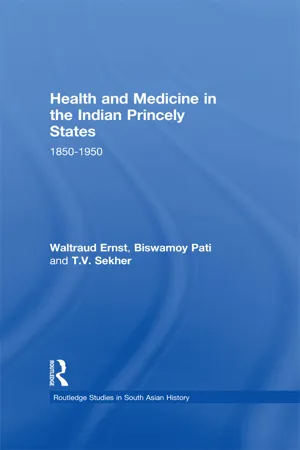
Health and Medicine in the Indian Princely States
1850-1950
- 168 pages
- English
- ePUB (mobile friendly)
- Available on iOS & Android
About This Book
Since the 1980s there has been a continual engagement with the history and the place of western medicine in colonial settings and non-western societies. In relation to South Asia, research on the role of medicine has focussed primarily on regions under direct British administration. This book looks at the 'princely states' that made up about two fifths of the subcontinent. Two comparatively large states, Mysore and Travancore – usually considered as 'progressive' and 'enlightened' – and some of the princely states of Orissa – often described as 'backward' and 'despotic' – have been selected for analysis. The authors map developments in public health and psychiatry, the emergence of specialised medical institutions, the influence of western medicine on indigenous medical communities and their patients and the interaction between them.
Exploring contentious issues currently debated in the existing scholarship on medicine in British India and other colonies, this book covers the 'indigenisation' of health services; the inter-relationship of colonial and indigenous paradigms of medical practice; the impact of specific political and administrative events and changes on health policies. The book also analyses British medical policies and the Indian reactions and initiatives they evoked in different Indian states. It offers new insights into the interplay of local adaptations with global exchanges between different national schools of thought in the formation of what is often vaguely, and all too simply, referred to as 'western' or 'colonial' medicine.
A pioneering study of health and medicine in the princely states of India, it provides a balanced appraisal of the role of medicine during the colonial era. It will be of interest to students and academics studying South Asian and imperial and commonwealth history; the history of medicine; the sociology of health and healing; and medical anthropology, social policy, public health, and international politics.
Frequently asked questions
Section 1
Mysore
1
Plague administration in Princely Mysore
Administrative measures to control plague
- (i) The establishment of railway medical inspection stations, at Harihar, Yeswantpur, Bowringpet, Bangalore Cantonment, Kengeri and Mysore City, under Notifications of the Resident or of the Durbar.
- (ii) The establishment of outposts and road inspection stations, manned by Police and village servants and within easy reach of segregation sheds; also of frontier inspection stations, especially in the Chitaldrug and Shimoga borders, systematically patrolled by special Inspectors; and the watching of the Bangalore City and Kolar Gold Fields at all approaches.
- (iii) The examination of passengers by rail and road.
- (iv) The detention, observation, or escort to their destination of persons arriving from infected areas or suspected of carrying infection.
- (v) The disinfection of houses and of passengers.
- (vi) The imposition on householders and others of the obligation to give immediate information of the occurrence of plague cases.
- (vii) The introduction of the “supervision system” into the Bangalore City, which was divided for the purpose into circles under Superintendents and further subdivided into blocks under Supervisors, who made daily inspection of each house with a view to ascertain all arrivals, departures, sicknesses, and deaths. On the outbreak of plague, this system was replaced by the Ward system, the Cities of Bangalore and Mysore being divided into Wards under Civil Ward Officers assisted by Medical Officers.
- (viii) The establishment of temporary plague hospitals and segregation and health camps at centres most likely to become affected.
- (ix) The stationing of Police constables at each burial and cremation ground in the Bangalore City to register every funeral, and, as far as possible, to ascertain the cause of death.
- (x) The encouragement of the destruction of rats by offer of rewards and otherwise.
- (xi) The prohibition of fairs and festivals at which large crowds were likely to collect, or of the attendance threat of persons from infected areas.
- (xii) The distribution of leaflets and the holding of meetings for explaining to the people the dangers of plague, the object of the measures adopted by government, and the necessity for popular co-operation.
- (xiii) The enforcement of special sanitary improvements in towns and villages.
Table of contents
- Cover
- Title
- Copyright
- Dedication
- Contents
- List of figures
- List of tables
- About the authors
- Acknowledgements
- Introduction
- SECTION 1 Mysore
- SECTION 2 The Orissan states
- SECTION 3 Travancore and Orissa
- Index